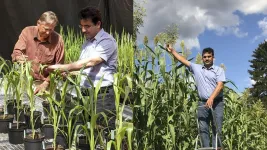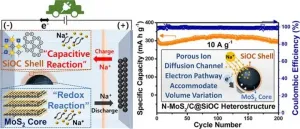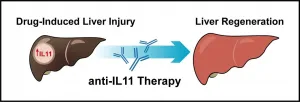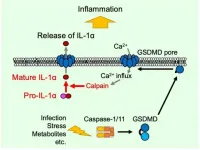Sweet sorghum: Sweet promise for the environment
New sorghum variety developed at KIT shows increased sugar accumulation and can be used for energy and materials production -- scientists report in Industrial Crops & Products
2021-06-18
(Press-News.org) Sweet sorghum can be used to produce biogas, biofuels, and novel polymers. In addition, it can help replace phosphate fertilizers. A new sweet sorghum variety developed at Karlsruhe Institute of Technology (KIT) accumulates particularly high amounts of sugar and thrives under local conditions. As the scientists reported in the Industrial Crops & Products journal, sugar transport and sugar accumulation are related to the structure of the plants' vessels. This was the result of a comparison between sweet and grain sorghums. (DOI: 10.1016/j.indcrop.2021.113550)
As the world's population grows, the demand for food, raw materials, and energy is also on the rise. This increases the burden on the environment and the climate. One strategy to reduce greenhouse gas emissions is to grow so-called C4 crops. These carry out photosynthesis particularly efficiently, are therefore more effective in fixing carbon dioxide (CO2), and build up more biomass than other plants. Usually, they are native to sunny and warm places. One of the C4 plants is sorghum, also known as great millet, a species of the sorghum genus in the sweet grass family. The varieties that are particularly rich in sugar are called sweet sorghum (Sorghum bicolor L. Moench). Other varieties include grain sorghum used as animal feed. Sorghum can be grown on so-called marginal land, which is difficult to cultivate, so it does not compete with other food or forage crops.
A new sweet sorghum variety called KIT1 has been developed by Dr. Adnan Kanbar in the Molecular Cell Biology Division research group headed by Professor Peter Nick at the Botanical Institute of KIT. KIT1 accumulates particularly high amounts of sugar and thrives especially well under temperate climate conditions. It can be used both energetically, i.e. for the production of biogas and biofuels, and as a base material for the production of novel polymers. The estimated sugar yield per hectare is over 4.4 tons, which would correspond to almost 3,000 liters of bioethanol. In addition, the digestate produced during biogas production can be used for fertilizers to replace phosphate fertilizer, which will soon be in short supply.
The Plant Stem Anatomy is What Matters
Researchers at Nick's laboratory, which is part of the Institute for Applied Biosciences, and their colleagues at the Institute for Technical Chemistry at KIT and at ARCUS Greencycling Technology in Ludwigsburg compared the KIT1 sweet sorghum and Razinieh grain sorghum varieties in order to investigate the different sugar accumulation behaviors in the plant stem. For the study, published in the Industrial Crops & Products journal, the team looked at the stem anatomy. This includes the thickened areas (nodes) and the narrow areas or spaces between nodes (internodes), but also transcripts of important sucrose transporter genes as well as stress responses of plants to high salt concentrations in the soil. Sugar accumulation was highest in the central internodes in both genotypes. However, a relationship was found between sugar accumulation and the structure of the vessels that serve to transport water, solutes, and organic substances. The vessels are grouped into vascular bundles. These consist of the phloem (bast part) and the xylem (wood part). The phloem mainly transports sugars and amino acids, while the xylem's primary function is to transport water and inorganic salts; in addition, the xylem has a supporting function. The study revealed that in KIT1 and five other sweet sorghum varieties, the phloem cross-sectional area in the stem is much larger than the xylem cross-sectional area - the difference is much more pronounced than in the Razinieh grain sorghum variety. "Our study is the first one to look at the relationship between the structure of the vascular bundles and sugar accumulation in the stem," Nick says.
Sweet Sorghum Copes Better with Salinity Stress
As the study further revealed, salinity stress led to higher sugar accumulation in KIT1 than in Razinieh. The expression of sucrose transporter genes was higher in KIT1 leaves under normal conditions, and increased significantly under salinity stress. "Besides anatomical factors, there also some molecular factors that might contribute to regulating sugar accumulation in the stem," Kanbar explains. "In any case, KIT1 responds better to salinity stress." (or)
INFORMATION:
Original Publication
Adnan Kanbar, Ehsan Shakeri, Dema Alhajturki, Michael Riemann, Mirko Bunzel, Marco Tomasi Morgano, Dieter Stapf, Peter Nick: Sweet versus grain sorghum: Differential sugar transport and accumulation are linked with vascular bundle architecture. Industrial Crops & Products, 2021. DOI: 10.1016/j.indcrop.2021.113550
Abstract at https://doi.org/10.1016/j.indcrop.2021.113550
Contact for this press release:
Sandra Wiebe, Press Officer, phone: +49 721 608-41172, e-mail: sandra.wiebe@kit.edu
Being "The Research University in the Helmholtz Association", KIT creates and imparts knowledge for the society and the environment. It is the objective to make significant contributions to the global challenges in the fields of energy, mobility, and information. For this, about 9,600 employees cooperate in a broad range of disciplines in natural sciences, engineering sciences, economics, and the humanities and social sciences. KIT prepares its 23,300 students for responsible tasks in society, industry, and science by offering research-based study programs. Innovation efforts at KIT build a bridge between important scientific findings and their application for the benefit of society, economic prosperity, and the preservation of our natural basis of life. KIT is one of the German universities of excellence.
[Attachments] See images for this press release:

ELSE PRESS RELEASES FROM THIS DATE:
2021-06-18
Scientists have developed a new technique that could revolutionise medical imaging procedures using light.
A team of physicists, led by Dr David Phillips from the University of Exeter, have pioneered a new way in which to control light that has been scrambled by passage through a single hair-thin strand of optical fibre. These ultra-thin fibres hold much promise for the next generation of medical endoscopes - enabling high-resolution imaging deep inside the body at the tip of a needle.
Conventional endoscopes are millimetres wide and have limited resolution - so cannot be used to inspect individual cells. Single optical fibres are approximately 10x narrower and can enable much higher-resolution imaging - enough to examine the features of individual ...
2021-06-18
Various automobile companies are preparing to shift from internal combustion (IC) engine vehicles to electric vehicles (EVs). However, due to higher cost, EVs are not as easily accessible to consumers; hence, several governments are subsidizing EVs to promote sales. For EV costs to compete with those of IC engine vehicles, their batteries, which account for about 30% of their cost, must be more economical than that of IC-based vehicles.
The Korea Institute of Science and Technology (KIST) has announced that Dr. Sang-Ok Kim's team at the Center for Energy Storage Research had developed a novel, high-performance, economical anode material for use in sodium-ion secondary batteries, which are ...
2021-06-18
New classes of drugs are biologic disease-modifying anti-rheumatic drugs (bDMARDs) and Januskinase inhibitors (JAKi). At the 2021 EULAR congress, Strangfeld and colleagues shared new data assessing the effects of these medications on the risk of serious infections in elderly people with RA. RA is an inflammatory autoimmune disease that causes pain, swelling, and stiffness in the joints, but it also affects other organ systems through underlying systemic inflammation, causing for example cardiovascular diseases or fatigue.
RABBIT is a prospective, observational cohort study in Germany. ...
2021-06-18
The loss of a loved one can be a defining moment, even in the animal world. In chimpanzees, for example, individuals whose mothers die when they are young are smaller than their counterparts, reproduce less and are also more likely to die at a young age. But why? To find out, an international research team* led by a CNRS researcher** studied the short- and long-term effects of maternal loss on the stress levels of orphaned chimpanzees over a 19-year period. By comparing the levels of a stress hormone marker, cortisol, between young and adult orphans and non-orphans, the scientists found that young ...
2021-06-18
The body is well protected against invading pathogens by barriers such as the skin. But if you injure yourself and break your skin, pathogens can easily enter your body through the wound and cause severe infections. If this occurs, the innate immune system takes over the first rapid defense with an effective arsenal of cellular weapons infiltrating the wounded tissue in large numbers. As one of the first cell types on the spot, neutrophil granulocytes are recruited within few hours from the bloodstream to the infection site to eliminate potential microbial invaders.
Swarming against infections
"Neutrophils are very efficient in hunting and ...
2021-06-18
Singapore, 18 Jun 2021 - Scientists at Duke-NUS Medical School and National Heart Centre Singapore (NHCS), in collaboration with colleagues in Singapore and the UK, have shown that the human form of the signalling protein interleukin 11 (IL-11) has a damaging effect on human liver cells--overturning a prior hypothesis that it could help livers damaged by paracetamol poisoning. The finding, published last week in Science Translational Medicine, suggests that blocking IL-11 signalling could have a restorative effect.
Paracetamol, also called acetaminophen, is a widely available over-the-counter painkiller, and an overdose can lead to serious liver damage and even death. It is the most common pharmaceutical ...
2021-06-18
Most of us have heard of Alzheimer's disease, a neurodegenerative disorder marked by brain cell death and the shrinking of the brain. It is the most common cause of dementia and cognitive impairment, which typically have a devastating effect on a person's quality of life. There is still no cure for Alzheimer's.
One way of tackling the progression of Alzheimer's disease (AD) is to prevent the underlying adverse changes in the brain. A team of researchers from the National Centre for Biological Sciences (NCBS) has recently published a study in the Journal of Medicinal Chemistry, dedicated to neuroprotection against these toxic changes. They used tiny free-living soil worms --called Caenorhabditis elegans--and the often-ornamental ...
2021-06-18
Kanazawa, Japan - Interluekin-1α (IL-1α) is an important part of the immune response, but until now it has been unclear how this molecule is processed from its precursor, pro-IL-1α, and exits the cell during inflammasome activation. Now, researchers from Japan have found that gasdermin D, a protein that was already known to mediate pyroptosis, a form of regulated cell death, plays a crucial role in the maturation and release of IL-1α.
In a study published in March in Cell Reports, researchers from Kanazawa University report that, when the ...
2021-06-18
COVID-19 has changed the world in unimaginable ways. Some have even been positive, with new vaccines developed in record time. Even the extraordinary lockdowns, which have had severe effects on movement and commerce, have had beneficial effects on the environment and therefore, ironically, on health. Studies from all around the world, including China, Europe and India, have found major drops in the level of air pollution. However, to fully understand the impact of anthropogenic causes, it is important to separate them from natural events in the atmosphere like wind flow.
To demonstrate this point, a new study by researchers at the Research Institute for Humanity and Nature, Japan, uses satellite data and mathematical modeling to explain just ...
2021-06-18
Identifying the causes of human neurodegenerative diseases is a global research priority, warranting frequent reviews of the accumulating knowledge. In doing just that, biologists from the Plant Physiology Laboratory at the University of Guam and neuroscientists from the Experimental Medicine Program at The University of British Columbia have published an update on the reputed environmental toxins that have been suspected of being involved in mammal neurodegeneration. Their summary was published in April in the book Spectrums of Amyotrophic Lateral Sclerosis, which is available online ...
LAST 30 PRESS RELEASES:
[Press-News.org] Sweet sorghum: Sweet promise for the environment
New sorghum variety developed at KIT shows increased sugar accumulation and can be used for energy and materials production -- scientists report in Industrial Crops & Products








